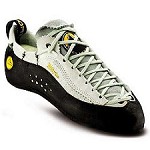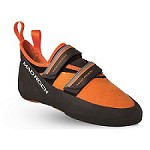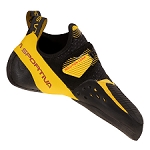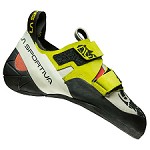Choosing climbing shoes is no easy task. Not only do you need to consider varying factors such as your climbing style, your grade or activity time, but also the specific shape of your foot and the limit of pain you are willing to endure. This article categorises the most iconic climbing shoes into groups to help you choose the most suitable model for your needs.

Different climbing shoes for different styles. Photo Samuël Bié/SCARPA.
A rather long thought process lurks in the head of the climber after deciding to renew his or her climbing shoes. Climbing shoes, that essential item for modern rock climbing, as loved for their performance as they are hated for their discomfort, have become a great source of confusion, due to the huge variety of models available on the market.
You may want to change shoes for either or both of the following reasons. On the one hand, the shoe you currently use no longer fulfils its function, due to a change in your level or climbing style, and on the other, you simply want to try a similar alternative.
We invite you to read our article on
how to choose your climbing shoes for information on the different types of climbing shoes, as well as tips on choosing the one that best suits your needs, style or grade.

Putting on climbing shoes at the foot of the climb. Photo: SCARPA
In this article we will respond to the queries frequently expressed by our customers, and explain the different alternatives from our best-selling models and brands, with emphasis on two of the most representative footwear manufacturers in northern Italy, SCARPA and La Sportiva. To do this we will group the models into four major categories, according to climbing style or grade.
1. The Beginner’s Climbing Shoe
When customers buy their first climbing shoe, they are more likely to express doubts on whether they are making a good investment ("I don't know if I'm going to like climbing") than technical questions about materials or geometry. However, most of the time, getting hooked on an activity like climbing has a lot to do with the confidence you get from your equipment as well as having fun, overcoming challenges and risk control.
To achieve this, it is essential to find a comfortable and precise shoe. Comfort and precision rarely go hand in hand with high grade shoes, yet they combine perfectly in shoes designed for beginners.
What should you look for in a beginner’s climbing shoe?
It’s important to gain confidence in your feet and check that you are indeed not going to slip and fall. Reliability, comfort and durability are therefore essential. Climbing shoes for beginners usually have some common features: thick soles that are stiff enough to provide support, a comfortable last so they can be worn for hours at a time and durable materials for intense use.
What models do we suggest?
SCARPA Origin, La Sportiva Tarantula and Tanta de Tenaya. Women’s model of the SCARPA Origin W and La Sportiva Tarantula W.

SCARPA Origin
The rising popularity of rock climbing and the increase of urban climbing walls have made these two models bestsellers. They share several similarities:
- Flat and symmetrical shape
.
- Velcro closure.
- 4 to 5mm rubber sole.
- Medium last with wide toe box.
- Leather upper.
- Comfortable leather upper.
What are the differences between the Origin, Tarantula and Tanta?
While most mid to high range climbing shoes in southern Europe use Vibram soles, the brands of these three models manufacture their own sole compounds.
If we look at the three compounds: SCARPA Vision, La Sportiva Frixion RS and Tenaya 4mm baked rubber, there are no significant differences in as far as performance, bearing in mind the kind of terrain and holds a beginner will encounter.
Good holds on easy climbs or abrasive resin holds in the gym do not require a top quality sole to avoid slipping, although these compounds would certainly be up to the task.
It is in the upper, where we will find the most notable differences. The upper material of the La Sportiva Tarantula is leather, which guarantees comfort and a certain amount of breathability that is not found in the plastic materials used for low priced products by white label brands. Quality uppers avoid excessive sweating and bad odour, which are common in the cheaper synthetic derivatives.
The SCARPA Origin uses a combination of suede and microfibre for the upper, which in theory, is better quality than the leather upper of the Tarantula and guarantees better performance even in terms of comfort. At first glance, the Origin is a well structured and high quality climbing shoe and its plush suede gives a warmer appearance which will attract those who are susceptible to the cold or enjoy winter climbing, but may be a disadvantage for anyone looking for a shoe for summer use or for indoor climbing walls.

Tenaya Tanta. Fairly symmetrical for enhanced comfort
The Tenaya Tanta uses a microfibre outer and a cotton lining, which combines the durability and breathability of microfibre with the next-to-skin comfort of cotton.
2. Climbing Shoes for Grade Progression
Vertical routes with hidden finger pockets and miniscule holds are examples of the kind of terrain where a a beginner’s climbing shoe is out of its league. These routes require asymmetrical geometry to allow you to get your toe in the right place and to offer support during a move. Unfortunately, the asymmetry and curvature of the sole has a price to pay in comfort, but SCARPA, La Sportiva and Tenaya have achieved a fairly adequate balance, allowing for progression without the usual level of suffering.
What should I look for in a climbing shoe if I want to reach the next grade?
It is difficult to distinguish at which point a beginner’s grade becomes an intermediate grade, although it is generally accepted that from 6b upwards, a different, more specific piece of equipment is required to allow you to adapt to the small holds and vertical or overhanging walls that usually appear from that grade on.

Climbing shoes for progressing to the next grade. Photo: SCARPA
Climbing shoes for progression are usually characterized by quality materials and a combination of geometry and sensitivity, in order to optimize support and to feel the smaller rock holds, in relative comfort, so that climbing does not become an insufferable exercise for your feet, especially in summer on or long routes.
Which models do you suggest?
SCARPA Vapor V and La Sportiva Miura VSand Tenaya Oasi. Women’s models: SCARPA Vapor V W, La Sportiva Miura VS Wand Tenaya Oasi LV.
These are classics with a multitude of admirers who replace them with the same model when it's time for a change. They provide precision for mid grades and relative comfort for long routes. Common features of both models:
- Versatile for use both at the gym and outdoors, especially for sport slab climbing
.
- The slightly curved and asymmetrical shape, provides technicality without sacrificing too much comfort.
- Velcro closure.
- Vibram XS Edge sole in men's Vapor V and Miura VS and XS Grip2 in the other models.
What are the differences between the Vapor V, Miura VS and Oasi?
Here, the differences are more striking which makes it easier to decide on which shoe best suits your physical needs and style of climbing.
The Scarpa Vapor V and the Tenaya Oasi have a slightly thinner sole than the La Sportiva Miura VS. This provides greater sensitivity so that you can feel the rock, but is not as stiff or as durable as a thicker sole. In practice, on a hard move, you’ll feel the rock hold more easily with a thinner sole, but you will need greater foot strength as the thinner sole offers less support.

Vibram XS Grip2 sole
The microfibre upper (blend of polyester and nylon) of the Vapor V and the Oasi could be the decisive factor if you are also considering the Miura VS, which is made of suede. The excellent sweat absorption capacity of the Vapor V and Oasi microfibre, as well as being a long-lasting fabric that won’t lose its shape, appeal to many climbers who want a sensitive shoe. The Miura VS, on the other hand, offers next-to-skin comfort and the natural feel of suede, which is ideal for long sport climbing sessions or multi-pitch wall routes.
The Vapor V has a slightly narrower last than the Miura VS and perhaps for that reason the number of Velcro straps between one model and another is different. Two Velcro straps for the Vapor V and the Oasi and three for the Miura VS, which maybe allows for a slightly more precise fit, providing your feet are not very narrow.
3. Climbing Shoes for Alpine Multi-pitch Routes
Special equipment is required for climbing long, classic routes or the kind of demanding alpine climbs that were first opened using boots, etriers and pitons. On such routes, you spend so long on the wall that your feet are unable to withstand the pressure, you alternate between wide ledges and demanding moves that require comfort and grip, or you climb at high altitudes and require the thermal protection of socks.
What should you look for in a climbing shoe for long routes?
These shoes are designed to be worn for hours at a time. Like beginner’s shoes, comfort is a priority, but they also require technical materials and quality finishing that allow you to reach your limit on complicated routes. Regarding geometry, although the sole is slightly concave and asymmetrical, this is a fairly flat shoe and fundamentally straight.
These climbing shoes can be defined as the real all-purpose climbing shoe, as it performs well on the widest range of climbing styles and degrees of difficulty. That said, however, this type of shoe is most popular with trad. climbers who prioritise comfort.
Which models do we suggest?
SCARPA Maestro Eco, La Sportiva TC Pro and adidas 5.10 Niad. And the adidas 5.10 Niad VCS W for women.
The technical performance and comfort of these two models will be a delight to many climbers. They may be considered a little stiff by those looking for extra sensitivity on slab routes, but they are ideal for rock variations and long routes. The features they have in common:
- Practically straight in shape to promote comfort and stiff enough to give support on difficult moves.
- Lightweight for high grades, both models are lace ups but lacing doesn’t reach the toes.
- Leather upper and medium last.
What are the differences between the Maestro, TC Pro and Niad?
They are very similar in terms of the type of climbing they are intended for, but they are quite different in terms of materials used, especially if we look at the sole. The first difference is obvious: the TC Pro is one of the few climbing shoes that cover the ankle, which is especially useful for cracks and foot jams as it provides greater support and protects the malleolus from abrasion although mobility is limited to a certain extent. For those who prefer SCARPA shoes, the Maestro Mid also has ankle protection.
As for sole components, the Italian models use Vibram XS Edge, which prioritizes durability over grip and Maestro plus XS Grip at the heel. The 5.10 Niad uses the brand’s own Stealth C4 outsole.
Curiously, after many years on the market, the TC Pro are now experiencing a second wave of success thanks to the Free Solo documentary on Alex Honnold’s free solo climb (without rope) of El Capitan in Yosemite.

Alex Honnold after completion of his free solo climb of El Capitán (Yosemite).
Photo Jimmy Chin/La Sportiva
4. Performance Climbing Shoes
A climbing shoe for higher grade sport climbs, technical bouldering or competition, usually has a fairly extreme design and features. Curved and asymmetrical, it squeezes the maximum ability from the climber to achieve the grade.
What do you look for in a high performance climbing shoe?
High performance climbing routes are pretty wild. Endless overhangs, microscopic holds and massive roofs are examples of what will appear on your way to the belay station and every second of torture, takes you closer to sending the route. A climber seeks to invest the maximum efficiency of his strength on each hold, even at the cost of sacrificing comfort. However, the models we recommend are not the most extreme and allow a certain amount of comfort if that word exists at this level. The reason Velcro models are common for high performance climbing is that they can be loosened quickly as soon as you reach the belay point.

Overhangs and tiny holds . Photo: Paolo Sartori/SCARPA
Which models do we suggest?
SCARPA Arpia and La Sportiva Skwama and Tenaya Iati. Women’s SCARPA Arpia W and La Sportiva Skwama W.
Climbing shoes with medium last, optimised to transmit energy to the toe.
- Softer models are more sensitive and allow you to feel the rock.
- Hooked profiles function well on overhangs.
- Vibram XS Grip2 3.5 mm sole.
- Velcro fastening.
- Microfibre upper.
What are the differences between the Arpia, Skwama and Iati?
Although these models are designed for high-grade sport climbing, bouldering or climbing walls, the absence of a top rubber toe patch excludes the Arpia from boulder hooking and foot jams. However, this absence of rubber provides much greater comfort by allowing better toe flex. That is the main difference and, will probably be the deciding factor between one model or the other according on your activity.
The single Velcro fastening strap on the two Italian models allows quick on/off, but the Arpia single strap that zig-zags up from the toe and hugs the foot seems a little more elaborate. The Spanish Tenaya employs a clever single pull strap that actually tightens three straps on the upper.
Conclusion
Clearly, many factors are involved when it comes to choosing a pair of climbing shoes. Not only do you need to consider the materials and the shape of the shoe, but you also need to think about more personal circumstances such as the shape of your foot, your grade, the tightness you can endure, types of routes you plan to climb and let’s not forget your personal taste and previous experience with other models and brands.
The models we present here are a selection of some of our best-sellers, but we have many other excellent models and brands. We therefore invite you to visit our stores and website, where our technical staff will be pleased to offer advice and where you can view a wide range of options to find the most suitable climbing shoe for your needs.


















Leave a comment
Be the first to comment on this article.